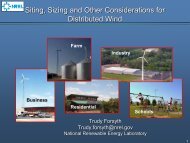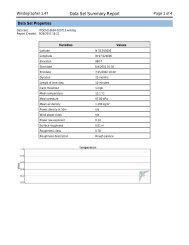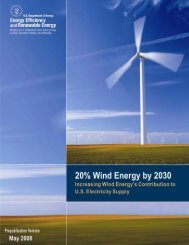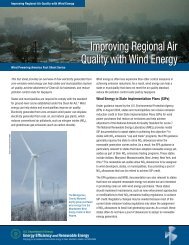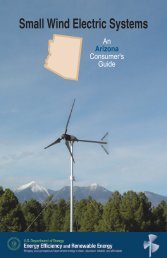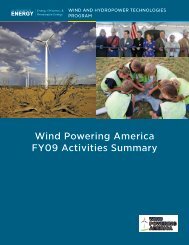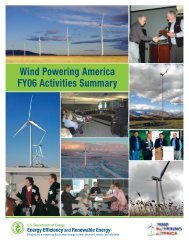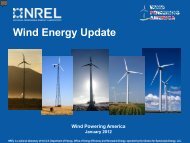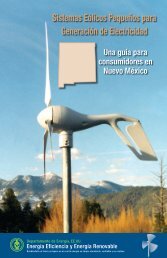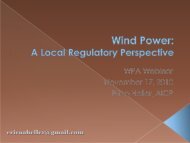(JEDI) Model: Offshore Wind User Reference Guide - NREL
(JEDI) Model: Offshore Wind User Reference Guide - NREL
(JEDI) Model: Offshore Wind User Reference Guide - NREL
Create successful ePaper yourself
Turn your PDF publications into a flip-book with our unique Google optimized e-Paper software.
Jobs and EconomicDevelopment Impact (<strong>JEDI</strong>)<strong>Model</strong>: <strong>Offshore</strong> <strong>Wind</strong><strong>User</strong> <strong>Reference</strong> <strong>Guide</strong>Eric LantzNational Renewable Energy LaboratoryMarshall GoldbergMRG and AssociatesDavid KeyserNational Renewable Energy Laboratory<strong>NREL</strong> is a national laboratory of the U.S. Department of EnergyOffice of Energy Efficiency & Renewable EnergyOperated by the Alliance for Sustainable Energy, LLCThis report is available at no cost from the National Renewable EnergyLaboratory (<strong>NREL</strong>) at www.nrel.gov/publications.Technical Report<strong>NREL</strong>/TP-6A20-58389June 2013Contract No. DE-AC36-08GO28308
Jobs and EconomicDevelopment Impact (<strong>JEDI</strong>)<strong>Model</strong>: <strong>Offshore</strong> <strong>Wind</strong><strong>User</strong> <strong>Reference</strong> <strong>Guide</strong>Eric LantzNational Renewable Energy LaboratoryMarshall GoldbergMRG and AssociatesDavid KeyserNational Renewable Energy LaboratoryPrepared under Task No. WE11.0510<strong>NREL</strong> is a national laboratory of the U.S. Department of EnergyOffice of Energy Efficiency & Renewable EnergyOperated by the Alliance for Sustainable Energy, LLCThis report is available at no cost from the National Renewable EnergyLaboratory (<strong>NREL</strong>) at www.nrel.gov/publications.National Renewable Energy Laboratory15013 Denver West ParkwayGolden, CO 80401303-275-3000 • www.nrel.govTechnical Report<strong>NREL</strong>/TP-6A20-58389June 2013Contract No. DE-AC36-08GO28308
SummaryThe Jobs and Economic Development Impact (<strong>JEDI</strong>) models, developed through the NationalRenewable Energy Laboratory (<strong>NREL</strong>), are user-friendly tools that estimate the economicimpacts of constructing and operating power generation projects for a range of conventional andrenewable energy technologies. This user reference guide for the offshore wind model wasdeveloped to help users understand and apply the model. The guide presents information on themodel’s underlying methodology, as well as the parameters and references used to develop thecost data contained in the model. This guide also contains basic instruction on model add-infeatures and model operation, along with a discussion of how the results should be interpreted.Based on project-specific inputs from the user, the model estimates job creation, earning, andoutput (total economic activity) for a given power generation project. This includes the direct,indirect, and induced economic impacts on the local economy associated with its constructionand operation phases. Project cost and local content data used in the model were gathered fromexisting offshore wind projects, a literature review, and conversations with industryprofessionals. Local direct, indirect, and induced jobs and economic impacts are estimated usingeconomic multipliers derived from Impact Analysis for Planning software. By determining theregional economic impacts and job creation for a proposed power facility, the <strong>JEDI</strong> offshorewind model can be used to answer questions about the impacts of offshore wind power in a givenstate, region, or local community.This report is available at no cost from theNational Renewable Energy Laboratory (<strong>NREL</strong>)at www.nrel.gov/publications.iii
Acronyms and AbbreviationsFTEfull-time equivalentIMPLANImpact Analysis for Planning model<strong>JEDI</strong>Jobs and Economic Development Impact modelkW ekilowatt electricMWmegawattMW emegawatt electric<strong>NREL</strong>National Renewable Energy LaboratoryO&Moperations and maintenanceThis report is available at no cost from theNational Renewable Energy Laboratory (<strong>NREL</strong>)at www.nrel.gov/publications.iv
Table of ContentsSummary ..................................................................................................................................................... iii1 Introduction ........................................................................................................................................... 12 <strong>Model</strong> Overview .................................................................................................................................... 23 Entering Data and Running the <strong>Model</strong> ............................................................................................... 53.1 Getting Started ............................................................................................................................... 53.2 Entering Data into the <strong>Model</strong> ........................................................................................................ 63.2.1 Simple Input Option ......................................................................................................... 63.2.2 Advanced Input Option .................................................................................................... 63.3 Viewing and Saving Results ......................................................................................................... 73.4 Accessing and Viewing <strong>Model</strong> Work Areas ................................................................................. 74 Interpreting the Results ....................................................................................................................... 94.1 Examining Economic Impacts and Jobs ........................................................................................ 94.2 Comparing Results Among <strong>JEDI</strong> <strong>Model</strong>s ................................................................................... 104.3 Understanding the Caveats .......................................................................................................... 115 <strong>User</strong> Add-in Location Feature ........................................................................................................... 126 Creating the <strong>Model</strong>: Data and Cost Categories ............................................................................... 146.1 Disaggregating Project Expenditures .......................................................................................... 146.2 Developing Detailed Project Cost Data ....................................................................................... 156.3 Estimating Local Content ............................................................................................................ 167 Validating <strong>JEDI</strong> Results ..................................................................................................................... 188 Resources ........................................................................................................................................... 20This report is available at no cost from theNational Renewable Energy Laboratory (<strong>NREL</strong>)at www.nrel.gov/publications.v
1 IntroductionThe <strong>Offshore</strong> <strong>Wind</strong> Jobs and Economic Development Impact (<strong>JEDI</strong>) model is designed todemonstrate the potential economic impacts associated with developing and operating offshorewind power plants in the United States. The primary goal in developing this model is to furnish atool for offshore wind developers, government officials, decision makers, parties with an interestin renewable energy, and other potential users to identify the possible regional, state, or localeconomic impacts associated with constructing and operating offshore wind power systems. Themodel allows users to quickly analyze the economic impacts and job creation potential ofoffshore wind technologies. Economic impacts are categorized into project development and onsitelabor impacts, turbine and supply chain impacts, and induced impacts, as defined in the nextsection of this report.Strong emphasis was placed on designing the model in a user-friendly format that can be easilymodified, reflecting different levels of project-specific information and user knowledge. Thisallows inexperienced spreadsheet users, those unfamiliar with economic impact analysis, andmore experienced and knowledgeable users to access the tool.The National Renewable Energy Laboratory (<strong>NREL</strong>) developed the offshore wind <strong>JEDI</strong> modelwith data collection assistance from the Navigant Consortium. The Navigant Consortium is thecollective team funded by the U.S. Department of Energy to develop an <strong>Offshore</strong> <strong>Wind</strong> AnnualMarket Assessment for the 3-year period from 2012 to 2014) and a one-time <strong>Offshore</strong> <strong>Wind</strong>Supply Chain Study (2012). Members of the Navigant Consortium include the American <strong>Wind</strong>Energy Association, the Great Lakes <strong>Wind</strong> Collaborative, Green Giraffe Energy Bankers,Navigant Consulting Inc., <strong>NREL</strong>, Ocean and Coastal Consultants, and TetraTech. Theconsortium is led by Navigant Consulting.This document describes the general use of the model, explains how to interpret outputsummaries, and outlines technical assumptions and cost models contained within the model. Ingeneral, the model relies on historical cost data from Europe and cost estimates for systems inthe United States to develop default values. These data introduce uncertainty because there aremany variables associated with offshore development. In addition, when the model was released,there were no U.S. offshore wind projects in operation. As a result, model data represent the bestinformation available to <strong>NREL</strong> at the time of the model’s development and publication. Foradditional questions about the <strong>JEDI</strong> models or model updates, please seehttp://www.nrel.gov/analysis/jedi/.This report is available at no cost from theNational Renewable Energy Laboratory (<strong>NREL</strong>)at www.nrel.gov/publications.1
2 <strong>Model</strong> OverviewThe model offers users the capability to analyze offshore wind projects in the United States.Given basic information about an offshore wind project (minimally, the state in which it is to belocated, the year of construction, and the nameplate capacity of the system), users can estimateproject capital and operating expenditures as well as the number of jobs, earnings, and economicactivity that will accrue to the region of analysis. 1 To evaluate these impacts, input-outputanalysis, also commonly referred to as multiplier analysis, is used.Input-output models were originally developed to trace supply linkages in the economy. Forexample, they show how purchases of offshore wind plant equipment not only affect equipmentmanufacturers but also the metal industries and other businesses supplying inputs to thosemanufacturers.The impacts that are ultimately generated by expenditures for offshore wind systems depend onthe extent to which those expenditures are spent locally and the structure of the local economy.Consistent with the local spending pattern and the state-specific economic structure, differentexpenditures support a different level of employment, income, and output.Input-output analysis can be thought of as a method for evaluating and summing the grossimpacts of a series of effects generated by an expenditure. To determine the total effect ofdeveloping an offshore wind project in the form of intuitive results, three separate impacts areexamined for each project scenario. These impacts are labeled in the offshore wind <strong>JEDI</strong> modelas follows:1. Project development and on-site labor impacts refer to the on-site or immediateeffects created by project expenditures. In constructing an offshore wind power plant,it refers to the on-site jobs of the contractors and crews hired to construct the plant.2. Turbine and supply chain impacts refer to the increase in economic activity thatoccurs when a contractor, vendor, or manufacturer receives payment for goods orservices and in turn is able pay others who support their businesses. For example, thisimpact includes the banker who finances the contractor who pays the foundationworkers and the steel mills and electrical manufacturers along the supply chain thatfurnishes the necessary materials. This category also includes the manufacturing ofoffshore wind plant equipment (e.g. offshore wind towers, blades, and nacelles,among others) that are used in the construction of the turbine.3. Induced impacts refer to the effects driven by spending of household earnings fromproject development and on-site labor impacts as well as turbine and supply chainimpacts. Induced results are often associated with increased business at localrestaurants, hotels, and retail establishments but also include childcare providers,1 Earnings (employee compensation) typically consist of wages, salaries, and benefits such as employer-providedhealth insurance and retirement. Earnings are not limited to this definition, however. Payments to proprietors (selfemployedindividuals), for example, might not come in the form of wages or a salary but are still consideredearnings if the payments are compensation for work performed.This report is available at no cost from theNational Renewable Energy Laboratory (<strong>NREL</strong>)at www.nrel.gov/publications.2
service providers, and any other entity affected by increased economic activity andspending occurring at the first two tiers.The sum of these three categories yields the total economic effect that results from a singleexpenditure. To accomplish this analysis at the state level, state-specific type I and type IImultipliers and personal consumption expenditure patterns are used to derive the results. 2 Thesestate-by-state multipliers for employment, wage and salary income and output (economicactivity), and personal expenditure patterns were derived from the Impact Analysis for Planning(IMPLAN) Professional <strong>Model</strong> Version 3.0 using state data. 3 The changes in expenditures frominvestments in developing offshore wind power plants are matched with their appropriatemultipliers for each sector affected by the change in expenditure.<strong>JEDI</strong> reports all job figures as full-time equivalent (FTE). One FTE is the equivalent of oneperson working full time for 1 year (2,080 hours). Two people working half time for 1 year, forexample, are the same as one FTE.<strong>JEDI</strong> results are calculated and reported for two phases: construction and operating. Constructionphase results are cumulative totals over the entire construction period; operating phase results areannual over the operating life of the project. <strong>JEDI</strong> does not assume a set life span, nor does itconsider potential impacts from a project’s decommissioning.Construction phase results are not affected by the duration of the construction period. The resultsfor a project that takes 1 year will be the same as a project that takes 5 years, assuming all costsare consistent. If desired, annual averages can be obtained by dividing construction results by thenumber of years it takes to build the wind farm. For example, if <strong>JEDI</strong> produces an estimate of100 FTE construction jobs supported by a project that takes 2 years to build, the estimate canalso be reported as an average of 50 jobs per year (100 / 2 = 50) during the 2-year constructionperiod.To analyze the local jobs and other economic impacts associated with wind farm workerearnings, the <strong>JEDI</strong> model allocates operations and maintenance (O&M) labor income accordingto IMPLAN personal consumption expenditure patterns. These expenditures reflect purchasesmade by an average household within the region of analysis. For example, for each dollar ofearnings a worker receives, a portion is spent on food, housing, insurance, and other necessary ordiscretionary goods or services. The model allocates this spending to those industries thatproduce the goods or services and then analyzes the associated direct, indirect, and inducedimpacts.<strong>JEDI</strong> contains default values representative of a “typical” offshore wind project constructed inwater with an average depth of 25 meters and no farther than 100 nautical miles from a port.These values allow users with limited knowledge of a specific project or those who simply are2Type I multipliers are used to calculate turbine and supply chain effects and type II multipliers are used to calculateinduced effects.3IMPLAN is a social accounting and impact analysis tool developed by the Minnesota IMPLAN Group (seewww.IMPLAN.com for more information). The initial version of the offshore wind <strong>JEDI</strong> model contains multipliersand personal consumption expenditure patterns for 2010, the most current year available when the model wasreleased for public use. <strong>NREL</strong> updates default multipliers and expenditure patterns approximately every 2 years.This report is available at no cost from theNational Renewable Energy Laboratory (<strong>NREL</strong>)at www.nrel.gov/publications.3
interested in a theoretical scenario to estimate potential economic impacts from a general project.These default values represent a reasonable expenditure pattern for constructing and operating anoffshore wind project in the United States. Admittedly, not every project will follow this exactdefault pattern for expenditures. Resource characteristics, project size, location, financingarrangements, and numerous site-specific factors influence the installation and operating costs.Similarly, the availability of local resources, including labor and materials, and the availability oflocally manufactured components can have a significant effect on the costs and the economicimpacts that accrue to the state or local region.This report is available at no cost from theNational Renewable Energy Laboratory (<strong>NREL</strong>)at www.nrel.gov/publications.4
3 Entering Data and Running the <strong>Model</strong>The <strong>JEDI</strong> model is designed for all levels of users. It requires minimal experience withspreadsheets and no background in economic modeling. The model contains instructions forentering data for analysis and informative comments meant to help users understand the type ofdata required in specific cells. The user can view the comments by pointing the cursor to the redtriangle located in the corner of select cells.<strong>User</strong>-modified data can be entered and saved with <strong>JEDI</strong>. These changes can be undone byclicking on Restore Default Values. <strong>JEDI</strong> defaults and model formulas are protected—projectscenario data can be changed but default data cannot.3.1 Getting StartedThe offshore wind <strong>JEDI</strong> model is based on Microsoft Excel. To begin using it, simply open theoffshore wind <strong>JEDI</strong> Excel file. The <strong>JEDI</strong> model opens to the Start tab, which briefly explainswhat the model is used for and outlines the steps for completing an economic impact analysis(see Figure 1).To learn more about the model version and history, click on the About <strong>JEDI</strong> tab.To begin a <strong>JEDI</strong> analysis, either click on the Start tab and click on Start Economic ImpactAnalysis or go to the Project Data tab.Figure 1. <strong>JEDI</strong> model Start pageThis report is available at no cost from theNational Renewable Energy Laboratory (<strong>NREL</strong>)at www.nrel.gov/publications.5
3.2 Entering Data into the <strong>Model</strong>Two modeling options are employed to accommodate a broad user base with a wide range ofknowledge about offshore wind projects. A simple or advanced input option allows a user tochoose the number and detail of user inputs that are accessible for the model (see Figure 2).3.2.1 Simple Input OptionFor users with limited experience with offshore wind power plants or economic impact analysis,the simple option requires minimal inputs such as the year in which construction starts, the stateor region in which the plant will be located, and the nameplate capacity of the power plant. Inaddition, the simple input option allows the user to specify the money value (dollar year) ofmodel results. This adjusts metrics reported by <strong>JEDI</strong> for expected inflation. 4 If the user hasadditional information about the offshore wind project, such as detail about the turbine size, thatcan be entered it as well. The simple option uses default project cost data in the analysis. To usethe simple input option, choose “Y” (Utilize Project Cost Data default values) in cell B30 on the“Project Data” page.3.2.2 Advanced Input OptionAn advanced model is available for users with more information or knowledge of offshore windprojects. This model allows users to enter project-specific details. The primary differencesbetween the simple model and advanced model options are the user’s ability to view and editdetailed model input data. The simple model uses default cost data and does not allow for userchanges to any of the detailed default cost data. The advanced model uses the same detailedmodel input data but allows users to override default inputs for all phases of the offshore windproject and use their own values. To use the advanced input option, choose “N” in cell B30 onthe Project Data page.If advanced input is selected, <strong>JEDI</strong> does not use the Money Value (Dollar Year) entry. In thiscase it is assumed that values entered by the model user are already adjusted for inflation.4 The inflation index is derived from the U.S. Office of Management and Budget (2012), Table 10.1, GrossDomestic Product and Deflators Used in the Historical Tables 1940–2016. Deflators for 2016–2031 assume anaverage annual inflation rate of 2.0%.This report is available at no cost from theNational Renewable Energy Laboratory (<strong>NREL</strong>)at www.nrel.gov/publications.6
Figure 2. <strong>JEDI</strong> model Project Data pageOnce project descriptive data input is complete, click on the Go To Summary Impacts button orsimply navigate to the Summary Results tab. The model estimates the number of jobs and othereconomic impacts supported throughout the construction/development and annual operatingphases. The model only estimates the impacts that accrue to the state or region being analyzed.These economic impact and job creation values are estimates for constructing and operating ahypothetical offshore wind power plant; they should not be interpreted as precise values.3.3 Viewing and Saving ResultsOnce the analysis is complete, users have several options for saving the data and results. To printhard copies, click on Print Project Data Summary and Summary Results to print the summarydata and results contained on the summary page, or click on Print Detailed Project Data to print adetailed version of all cost and expenditure data used in the analysis. Clicking the Export buttonexports the data and results to a separate Excel file. To save the entire model (with the usermodifieddata) for future use or reference, choose Save As from the Excel menu, rename themodel, and choose a directory. <strong>User</strong>s with Excel 2007 or newer should save the file with amacro-enabled “.xlsm” extension because the file uses macros. Changing the name ensures thatthe original model (with model defaults) is kept intact for future analysis. The option to simplycopy and paste any desired cells to another spreadsheet or document is always available.3.4 Accessing and Viewing <strong>Model</strong> Work AreasTo help ensure that the <strong>JEDI</strong> model is as user-friendly as possible, calculations, deflators, anddefault data are contained within their own worksheets. If desired, these can be viewed (but notThis report is available at no cost from theNational Renewable Energy Laboratory (<strong>NREL</strong>)at www.nrel.gov/publications.7
edited) by clicking on the respective worksheet and scrolling to the right. Viewing theworksheets will not affect the operation of the model.Multipliers, household expenditures, and two calculation work areas specific to offshore windare also contained within their own worksheets. To adhere to licensing agreements that coverproprietary data, these worksheets are hidden, locked, and cannot be viewed. Multiplier andhousehold expenditure data can be changed; this is covered in Section 5 of this guide.This report is available at no cost from theNational Renewable Energy Laboratory (<strong>NREL</strong>)at www.nrel.gov/publications.8
4 Interpreting the Results<strong>JEDI</strong> results contain information to help users better understand the magnitude of the economicimpacts associated with the scenario being analyzed. The model provides basic projectinformation to help users identify construction-related spending levels and ongoing O&Mexpenditures. The model also displays the portion of the spending assumed to occur locally(determined by the Local Share values—default or user-modified—used in the model for each ofthe expenditures). Similarly, the model displays local spending on debt and equity payments,property taxes, and land lease payments, if applicable.4.1 Examining Economic Impacts and JobsIn addition to the basic system information and costs, the model analyzes and reports the localjobs, earnings, and gross output (economic activity) supported by the project for the constructionphase and for the ongoing operations phase. For the construction phase, the impacts are brokenout by project development and on-site labor impacts, including construction labor andconstruction-related services, turbine and supply chain impacts, and induced impacts. Operatingphase impacts are broken out by on-site, local revenue and supply chain, and induced.For example, users interested in understanding the potential economic impacts from installing a50-MW e offshore wind plant off the coast of Massachusetts, built in 2015, can easily and quicklyfind the answers by using the <strong>JEDI</strong> model.Figure 3 shows the job and economic impact summary for a 50-MW e offshore wind plant(simple model option) constructed in 2015. By incorporating capacity, capital cost, and O&Mcost inputs and accepting the rest of the model defaults, a user can obtain summary results. Theproject data summary and local economic impacts summary result from the model run are alsoshown. The results from this estimate show that 316 FTE jobs are supported, generating morethan $24 million in earnings and more than $61 million in total economic activity during projectdevelopment and construction. These results include a total of 83 FTE jobs 5 from projectdevelopment (40 construction and 42 construction services), 122 from the turbine and supplychain, and 111 from induced impacts. Once the project is producing power, the user finds that 3full-time O&M jobs are created and sustained for the life of the facility, with another 27supporting jobs through supply chain and induced impacts, for a total of 30 full-time jobsassociated with plant operations.5 Because of the allowance of partial FTEs and rounding, total jobs reported may not equal the sum of FTEs listed insubsets of the summary table.This report is available at no cost from theNational Renewable Energy Laboratory (<strong>NREL</strong>)at www.nrel.gov/publications.9
Note: Because of continuous updates and improvements to the <strong>JEDI</strong> model, it may not be possible to exactlyreproduce the results of this model run.Figure 3. Project data summary and local economic impacts summary results from offshore wind<strong>JEDI</strong> run4.2 Comparing Results Among <strong>JEDI</strong> <strong>Model</strong>sCapacity factor and energy generation should be considered when comparing the economicdevelopment impacts from different power generation technologies. When comparing resultsfrom <strong>JEDI</strong> models for different power technologies (i.e. solar, wind, or fossil), it isrecommended that users compare facilities with equivalent energy generation instead ofcomparing facilities with a similar nameplate capacity (e.g., compare jobs per kilowatt-hoursgenerated per year, not jobs per kilowatts installed).This report is available at no cost from theNational Renewable Energy Laboratory (<strong>NREL</strong>)at www.nrel.gov/publications.10
4.3 Understanding the CaveatsSeveral important caveats should be noted:The intent of the offshore wind <strong>JEDI</strong> model is to construct a reasonable profile of expenditures(i.e., development services, materials and equipment costs, construction labor, and operatingcosts) and demonstrate the magnitude of the gross economic impacts that could result, 6 assuminga project is built and operates during the stated period of analysis. Given the unique nature ofoffshore wind resources and the changing nature of the industry, including expected changes asdevelopment activity in the United States increases and offshore wind technologies mature, theanalysis is not intended to precisely project expected impacts. Instead, the analysis should beviewed as an estimate of the overall magnitude of the impacts.<strong>JEDI</strong> is a static model. As such, it relies on inter-industry relationships and personal consumptionpatterns existing in the year of the multipliers. The model does not account for shifts in industryinputs or changes in consumption patterns that could result from changes in prices. <strong>Model</strong> resultsassume that all inputs—such as industry, materials, labor, and capital, among others—necessaryto complete a project will be available. The model assumes that local resources and productionand service capabilities are adequate to meet the level of local demand identified in the modelingassumptions. Similarly, the model does not automatically take into account industry productivityimprovements that may occur over time or changes that may occur in the construction oroperations processes (e.g., production recipe for labor, materials, and service cost ratios) for newoffshore wind plants. Should users wish to examine the impacts as the wind industry changes ormatures (e.g., lower costs in the future), such inputs must be developed external to the model andincorporated in the requisite model input locations.The model was not designed to project cash flow or to be used as a cash flow analysis tool.<strong>NREL</strong> offers financing models and tools that address cash flows in detail. 7The analysis assumes that the output from the offshore wind system and the specific terms of apower purchase agreement generate sufficient revenues to accommodate the equity and debtrepayment and annual operating expenditures. To the extent that additional revenues (i.e., profitsand tax advantages above actual costs) accrue to the project owner, there will be added impacts,but these are not included in <strong>JEDI</strong> analysis.<strong>JEDI</strong> results are gross as opposed to net. <strong>JEDI</strong> does not incorporate potentially far-reachingimpacts that may arise as a result of a project such as greenhouse gas emissions, changes inutility rates, property values, or displaced investment.6The <strong>JEDI</strong> models do not estimate the displaced energy or associated jobs, earnings, and output related to existingor planned energy generation resources (e.g., jobs lost in the operation of natural gas or coal plants because ofdiminished need for electricity production from these plants, given increased generation from wind) or increases ordecreases in jobs related to changes in electric utility revenues and consumer energy bills, among other impacts. Asa result, the estimates represent gross rather than net impacts.7The Cost of Renewable Spreadsheet Tool (CREST) is available for download athttp://financere.nrel.gov/finance/content/crest-model.This report is available at no cost from theNational Renewable Energy Laboratory (<strong>NREL</strong>)at www.nrel.gov/publications.11
5 <strong>User</strong> Add-in Location FeatureThe initial design of the <strong>JEDI</strong> models provided only for state-level impact analysis. It wasapparent, however, that many potential users might wish to perform a similar level of analysisfor different levels of geography. To accommodate these users, the <strong>User</strong> Add-in Location featureallows <strong>JEDI</strong> to be used with multipliers from sources other than IMPLAN (such as the U.S.Bureau of Economic Analysis).This feature allows users with the capability to derive or obtain the necessary data to completeanalysis for a specific region of interest. There are several necessary inputs. The number ofdirect, indirect, and induced jobs, earnings, and output per million dollar change in final demandmust be supplied. In addition, consumer expenditures must be specified. These expendituresreflect the percent of total expenditures that households spend on output from each industry. Thesum of all consumer expenditures is 100%. All data – multipliers and expenditures – need to bespecified for each industry. <strong>User</strong>s have the choice to either use 14 aggregated industries or the432 IMPLAN industry sectors. The aggregated industries follow:1. Agriculture2. Construction3. Electrical equipment4. Fabricated metals5. Finance, insurance, and real estate6. Government7. Machinery8. Mining9. Other manufacturing10. Other services11. Professional services12. Retail trade13. Transportation, communication, and public utilities14. Wholesale trade.For IMPLAN users, gathering the necessary data will require several steps:1. Purchase the desired county or state-level data files.2. Using IMPLAN Version 3 software or the most current available, create a new modelwith the desired region (one county, a group of counties, or a group of states).3. Construct the model.4. Export all industry multipliers for employment, employee compensation, and output tospreadsheet files.This report is available at no cost from theNational Renewable Energy Laboratory (<strong>NREL</strong>)at www.nrel.gov/publications.12
5. Format data contained in each of these files to input (i.e., cut and paste) into thedisaggregated portion of the respective location (My County for a single county or MyRegion for a group of counties or states) in the <strong>User</strong> Add-in Location worksheet in <strong>JEDI</strong>.6. Aggregate the model, which requires creating a new 14-industry aggregation scheme.The <strong>JEDI</strong> template used to aggregate the state multipliers into the 14 industries listedpreviously is available by request from <strong>NREL</strong>. 87. Reconstruct the model.8. Export household local commodity demand (personal consumption expenditures) andmultipliers for employment, employee compensation, and output to spreadsheet files.9. Format data contained in each of these files to input (i.e., cut and paste) into therespective location (My County for a single county or My Region for a group of countiesor states) in the <strong>User</strong> Add-in Location worksheet in <strong>JEDI</strong>.Once the user data are entered into the <strong>JEDI</strong> model, the user need only identify the location ofthe offshore wind system (in the project description section of the Project Data worksheet) as MyCounty or My Region, depending upon the type of data and where the data are entered, andproceed with the analysis.For non-IMPLAN users or those unfamiliar with input-output modeling, there are several optionsfor gathering the necessary data to perform specific county or regional analysis 9 . These include:1. Follow a similar process as that noted above to derive the aggregated and disaggregatedmultipliers and consumer expenditure data (aggregated) from another input-outputmodeling tool.2. Purchase the necessary data (aggregated and disaggregated multiplier and consumercommodity demand—see description above) from an input-output data provider.3. Obtain desired updates from the model developer or some other person or organizationskilled in input-output modeling.8Contact <strong>NREL</strong> at <strong>JEDI</strong>Support@nrel.gov.9 As a federally funded research and development center, <strong>NREL</strong> cannot recommend or endorse particular productsor services.This report is available at no cost from theNational Renewable Energy Laboratory (<strong>NREL</strong>)at www.nrel.gov/publications.13
6 Creating the <strong>Model</strong>: Data and Cost CategoriesAnalyzing the economic impacts of constructing and operating offshore wind plants requires alarge amount of project- and location-specific data. These include project capital costs, laborrates, state- (or region-) specific input-output multipliers, personal expenditure patterns, andprice deflators.Before formal model development began, a representative project was defined. This is critical,particularly for offshore wind because plant components (e.g., substructure type) andexpenditures are highly sensitive to project parameters. For this first iteration of the offshorewind <strong>JEDI</strong> model, a representative project was derived based on a review of the multiple projectproposals and concepts under consideration at the time of the model’s development. Therepresentative project was developed principally to align with a hypothetical project expected tocome online in the latter half of this decade and to be indicative of project parameters associatedwith a second round of North American projects (i.e., not a first-of-a-kind commercial-scale orpilot project). Table 1 summarizes the representative project parameters on which the currentoffshore wind <strong>JEDI</strong> model is based. If projects considered in future model analysis differ fromthe project parameters listed in the table, revisions to the default model inputs and potentially tothe model structure itself may be necessary.Table 1. Basic Project Parameters for the Representative <strong>Offshore</strong> <strong>Wind</strong> Project That Underlies<strong>Offshore</strong> <strong>Wind</strong> <strong>JEDI</strong>Installed CapacityTurbine SizeWater DepthSubstructure TypeDistance to Staging PortDistance to Point of InterconnectionDistance to Servicing PortSite Location500 MW5 MW25 metersJacket100 miles50 miles
for their impact within their respective sectors and then summed to estimate the total impact ofbuilding and operating the plant. Functionally, an offshore wind project must be broken downinto its constituent industries including, for example, rolled steel production, steel fabrication,fiberglass assembly and manufacturing, marine services, and commercial construction. Laborexpenditures are also isolated from capital or equipment expenditures wherever possible.Having previously defined a representative project, the first step in developing the offshore wind<strong>JEDI</strong> model was to develop a detailed list of line item expenditures with high enough resolutionthat a given expenditure could be assigned to its respective IMPLAN sector. At the same time,the resolution needed to be low enough that the input data were known or could be estimated. Toaccomplish this, <strong>NREL</strong> developed an initial set of line items that were circulated among thevarious members of the Navigant Consortium. Feedback was obtained and incorporated. Thisprocess resulted in the detailed line items for project costs in the model’s Project Data worksheet.Both construction and operating costs are broken into their constituent elements and laborexpenditures are isolated from capital expenditures in many cases. The project specific datainputs include the following:1. Turbine costs (e.g., nacelle, blades, and towers)2. Materials and equipment costs (e.g., basic construction materials, foundation,substructure, collection system, high-voltage cable, converter stations, and substations)3. Labor costs (e.g., foundation, substructure, and management/supervision)4. Insurance5. Development costs (e.g., engineering, legal, ports and staging, and marine transportation)6. Annual operational labor costs7. Annual materials and services costs8. Other parameters (e.g., financial—debt and equity and taxes and payroll).As explained previously, projects that deviate significantly from this set of expenditure types,potentially including projects that rely on substructures other than jackets, may not lendthemselves to modeling in offshore wind <strong>JEDI</strong> without revisions in inputs or in the underlyingmodel structure.6.2 Developing Detailed Project Cost DataWith the requisite project expenditure disaggregation in place, the next step was to identify thedetailed costs associated with each expenditure item. In a mature industry, such data could bederived from reports and studies documenting costs based on years of industry experience withdeveloping, constructing, and operating plants. The relative nascence of the offshore industry,though, required a different approach. In addition, the level of resolution required by the <strong>JEDI</strong>model goes well beyond the data that are typically available in the public domain. To develop thecost input data, <strong>NREL</strong> and the Navigant Consortium estimated the costs associated withindividual line items (for the representative project described previously) independently. Thisbottom-up approach to documenting and developing appropriate cost estimates used variousmethods, including the following:This report is available at no cost from theNational Renewable Energy Laboratory (<strong>NREL</strong>)at www.nrel.gov/publications.15
• Estimates derived from international experience (e.g., financing and development costs)• Market data (e.g., turbine prices and O&M costs)• Component-level cost models within <strong>NREL</strong> and other industry partners (e.g., turbinetowers, blades, and nacelle)• Calculated labor requirements and assumed wage rates (e.g., project management)• Contractor bids for fabrication and assembly work associated with hypothetical designs(e.g., jackets and electrical infrastructure).Once individual expenditures were estimated, subsystem costs and totals were compared—afteradjusting for differences in project parameters—with estimates derived elsewhere in theliterature (Tegen et al. 2012; BVG Associates 2011; Deloitte 2011; Douglas-Westwood 2010).Next, the estimates were refined.6.3 Estimating Local ContentIn developing the offshore wind <strong>JEDI</strong> model, it was necessary to estimate a local sharepercentage for each expenditure. The local share allows the model to analyze the economicimpact that accrues to the local area (state or geographic area). In this way, monetary leakages(spending on goods and services outside the local area) are not included in calculating localimpacts. With no significant offshore wind industry or development activity in the United Statestoday to draw on, but recognizing that many industries can easily support an offshore market inthe future, <strong>NREL</strong> and the Navigant Consortium developed local content for each expenditure.Table 2 summarizes the initial construction period local content estimates. These estimatessuggest that, for projects slated to come online by 2020 (the time frame of the representativeproject described previously), total construction period local content is likely to be relativelylow, on the order of 10% of total construction period costs. In addition, the vast majority of localexpenditures will be for development-related activities and construction services. These includeenvironmental and engineering studies, port upgrades and staging, air and marine transportationto and from the project site, and potentially turbine transport and installation. Projectmanagement and basic construction materials (e.g., gravel, concrete, and basic hardware) arealso expected to be procured locally.Table 2. Summary of <strong>JEDI</strong> Construction Period Local Content ValuesSummary Project Line ItemAggregate EstimatedLocal Content (%)Turbine and Electrical Infrastructure 2Labor 2Development and Construction Services 63Other 0Total Construction Period Local Content 10This report is available at no cost from theNational Renewable Energy Laboratory (<strong>NREL</strong>)at www.nrel.gov/publications.16
Generally, operations period activities are expected to be somewhat more dependent on localsources of goods and services (Table 3). Aggregate local content is estimated to beapproximately 45% of operations period total annual expenditures. Current estimates assume thattechnicians and administrative support are based locally and that management is situatedelsewhere. Other than replacement parts, all general materials and services (e.g., transport,subcontractors, and equipment) are assumed to be procured locally.Table 3. Summary of <strong>JEDI</strong> Operations Period Local Content ValuesSummary Project Line ItemAggregate EstimatedLocal Content (%)Labor 54Materials and Services 44Total Annual Operations Period Local Content 45Even though these estimates were developed with the intention of being broadly representative,they are also based on subjective estimates of existing industries and the ability of theirdistribution networks to support future offshore wind construction and operations activity. Theexisting industry structures in North America for land-based wind, and in Europe for offshorewind, were also considered. For example, because basic raw materials such as concrete andgravel are generally accessible locally and are costly to transport, the incentive to acquire thesegoods locally is strong. In contrast, because offshore turbine equipment tends to be larger andmore difficult to transport over land, the existing land-based wind manufacturing industry is notexpected to support near-term offshore wind projects. Instead, this equipment, at least in theearly stages of the industry, is assumed to be imported from existing European offshore windmanufacturers. Ultimately, the estimates are based on what might be reasonable for initialprojects, assuming current levels of workforce specialization and capabilities.The default local content estimates may or may not reflect actual project specific expenditurepatterns. In fact, even in the existing land-based wind industry, project expenditures vary widely.Moreover, with many states and local jurisdictions considering net economic impact tests in theirapproval process, project developers may be required to procure more goods and serviceslocally. Under such conditions, local content may be much higher than envisioned here. Wherebetter estimates of local or regional content are available, it is strongly recommended that usersincorporate them in their analyses.This report is available at no cost from theNational Renewable Energy Laboratory (<strong>NREL</strong>)at www.nrel.gov/publications.17
7 Validating <strong>JEDI</strong> ResultsThe offshore wind <strong>JEDI</strong> model has undergone both peer review and internal testing. Core datadescribed previously (project line items, costs, and local content) were reviewed both internallyby <strong>NREL</strong> and the Navigant Consortium and externally by members of the academic communityand the offshore wind industry. In addition, model inputs and preliminary results were presentedin public on at least three different occasions. In each instance, feedback on both the inputs andpreliminary results was solicited and incorporated into the publicly released version of themodel.<strong>NREL</strong> also conducted an internal benchmarking effort where the results from the offshore wind<strong>JEDI</strong> model were analyzed in relation to those reported elsewhere in the literature. In addition tocomparing results, <strong>JEDI</strong> model inputs were adapted to reflect many of the same inputs and dataapplied in other studies and results were compared again. Table 4 shows how the offshore wind<strong>JEDI</strong> model construction period results compared with other estimates when inputs wereadjusted to reflect changes in the local content in accord with estimates elsewhere in theliterature. These data indicate that the <strong>JEDI</strong> model is generally capable of replicating the broadrange of impacts reported by others, assuming variability in local content ranging from 7% to100%. This analysis reveals that much of the variability in estimated impacts is a function ofdifferent assumptions around key variables such as installed capital cost and local content.Table 4. Comparison of Construction Period AnalysisStudyEstimated Total ConstructionPeriod (FTE/MW)Global Insight (2003) 1.4–2.4Flynn and Carey (2007) 2.0–3.7Coad and Antunes (2010) 25–29Hagerman et al. (2010) 39Bloomberg New Energy Finance (Global Direct)(2012) 17<strong>Offshore</strong> <strong>JEDI</strong> 5–25–40Note: Construction period <strong>JEDI</strong> results are based on the estimated impacts for local content of 7%, 45%, and 100%.Results differ from <strong>JEDI</strong> estimates due to a combination of factors. Different modelingtechniques, capital costs, and local content assumptions all contribute to differences. The lowestend of the literature range, though, was below that reported by <strong>JEDI</strong>. This apparent discrepancyis the result of much lower capital costs assumed by analysts in the early 2000s. Estimates fromother more recent studies fall within the range of results produced by <strong>JEDI</strong>.During operations, impacts estimated by <strong>JEDI</strong> and throughout the literature are less substantial interms of FTE/MW (Table 5), because expenditures required to maintain and operate a facility aremuch lower than those required to develop and construct a plant. These estimates, however, arealso generally more consistent across studies. In addition, operations period FTEs represent longtermjobs. The relatively lower variability among operations period estimates is related to thelower level of expenditures as well as greater consistency in terms of estimated local content.During operations, much of the basic labor and services can be procured locally, but specializedThis report is available at no cost from theNational Renewable Energy Laboratory (<strong>NREL</strong>)at www.nrel.gov/publications.18
parts and equipment will not be locally available in most cases. Accordingly, estimating localcontent across projects is a somewhat more straightforward task.The largest differences between <strong>JEDI</strong> estimates and the literature estimates often result from thefact that some studies focus exclusively on on-site technicians (direct) estimates. Although thereis consistency between <strong>JEDI</strong> calculated impacts and the literature relative to the constructionperiod, <strong>JEDI</strong> operations period estimates appear to be marginally higher than those foundelsewhere in the literature. This is largely the result of two factors: (1) higher O&M andreplacement costs in <strong>JEDI</strong> because the representative project (described previously) is locatedfarther from shore than is typical of the international industry to date; and (2) slightly higheroperations period costs in general. These cost estimates have edged upward as the offshore windindustry has developed and more operational experience has been gained.Table 5. Comparison of Operations Period AnalysisStudyEstimated Total OperationsPeriod (FTE/MW)Global Insight (2003) 0.37Flynn and Carey (2007) 0.20–0.33Coad and Antunes (2010) 0.3Oxford Economics (2010) 0.28–0.43Boettcher et al. (2008/2010) 0.34Carbon Trust (2008) 0.27–0.36Goulden and Isola (2009)0.12 (Direct)Global <strong>Wind</strong> Energy Council (GWEC; 2008) 0.33Ladenburg et al. 2005 (Horns Rev) 0.31Ladenburg et al. 2005 (Nysted) 0.11Cambridge Econometrics; University of Warwick Institute for0.34–0.38Employment Research; IFF Research (2011)Bloomberg New Energy Finance0.13–0.17 (Direct)<strong>Offshore</strong> <strong>JEDI</strong> 0.4–0.6–1.1*Note: Operations Period <strong>JEDI</strong> results are based on impacts for local content of 35%, 60%, and 100%.This report is available at no cost from theNational Renewable Energy Laboratory (<strong>NREL</strong>)at www.nrel.gov/publications.19
8 ResourcesBloomberg New Energy Finance (2012). <strong>Wind</strong>, Solar-Research Note: Solar and <strong>Wind</strong> Sectors onCourse to Employ 2 Million People Worldwide by 2020. March 5.Boettcher, M.; Nielsen, N.P.; Petric, K. (2008). Employment Opportunities and Challenges in theContext of Rapid Industry Growth. Boston, MA: Bain & Company.BVG Associates (2011). <strong>Guide</strong> to an <strong>Offshore</strong> <strong>Wind</strong> Farm. Published on behalf of the CrownEstate. Swindon, UK: BVG Associates. Accessed August 2013:http://www.thecrownestate.co.uk/media/211144/guide_to_offshore_windfarm.pdf.Cambridge Econometrics; University of Warwick Institute for Employment Research; IFFResearch (2011). Working for a Green Britain: Volume 2. A report commissioned byRenewableUK and EU Skills. London, UK: RenewableUK and EU Skills. Available fordownload: http://www.renewableuk.com/en/publications/reports.cfm/Working-for-a-Green-Britain-Volume-2.Carbon Trust (2008). <strong>Offshore</strong> <strong>Wind</strong> Power: Big Challenge, Big Opportunity: Maximizing theEnvironmental, Economic, and Security Benefits. London, UK: The Carbon Trust.Coad, L.; Antunes, P. (2010). Employment and Economic Impacts of Ontario’s Future <strong>Offshore</strong><strong>Wind</strong> Power Industry. Ottawa, Ontario: The Conference Board of Canada.Deloitte (2011). Analysis on the Furthering of Competition in Relation to the Establishment ofLarge <strong>Offshore</strong> <strong>Wind</strong> Farms in Denmark. The Danish Ministry of Climate and Energy (ENS).Accessed August 2012: http://www.ens.dk/da-DK/UndergrundOgForsyning/VedvarendeEnergi/Vindkraft/Havvindmoeller/Fremtidens%20havmoelleparker/Documents/Deloitte%20Background%20report%202%20-%20Analysis%20of%20competitive%20conditions%20within%20the%20offshore%20wind%20sector.pdf.Douglas-Westwood (2010). <strong>Offshore</strong> <strong>Wind</strong> Assessment for Norway. The Research Council ofNorway. Accessed August 2012:http://www.nve.no/Global/Energi/Havvind/Vedlegg/Annet/<strong>Offshore</strong>%20<strong>Wind</strong>%20Asessment%20For%20Norway%20-%20Final%20Report%20-%20190510%20with%20dc.pdf.Flynn, R.; Carey, R. (2007). The Potential Economic Impact of an Off-Shore <strong>Wind</strong> Farm to theState of South Carolina. Clemson, SC: The Strom Thurmond Institute, Clemson University.Global Insight (2003). Economic Impact Analysis of the Cape <strong>Wind</strong> Off-Shore RenewableEnergy Project. A report prepared for Cape <strong>Wind</strong> Associates.Goulden, M.; Isola, C. (2009). Mapping Renewables Skills: ‘Green Collar’ Jobs in the PowerSector. EnergyTechnologies Institute. A report for The National Skills Academy of Power.This report is available at no cost from theNational Renewable Energy Laboratory (<strong>NREL</strong>)at www.nrel.gov/publications.20
GWEC; Greenpeace International (GPI). (2008). Global <strong>Wind</strong> Energy Outlook 2008. Brussels,Belgium: GWEC and GPI.Ladenburg, J.; Dubgaard, A.; Matensen, L.; Tranberg, J. (2005). Economic Valuation of theVisual Externalities of <strong>Offshore</strong> <strong>Wind</strong>. Report No. 179. Copenhagen, DK: Food and ResourceEconomic Institute.Oxford Economics (2010). Analysis of the Employment Effects of the Operation andMaintenance of <strong>Offshore</strong> <strong>Wind</strong> Parks in the UK. A Report for Vestas <strong>Offshore</strong>. Oxford, UK:Oxford Economics.Tegen, S.; Hand, M.; Maples, B.; Lantz, E.; Schwabe, P.; Smith, A. (2012); 2010 Cost of <strong>Wind</strong>Energy Review. Golden, CO: <strong>NREL</strong>. Accessed February 2013:http://www.nrel.gov/docs/fy12osti/52920.pdf.U.S. Office of Management and Budget (2012). Budget of the United States Government,Historical Tables, Fiscal Year 2012. Table 10.1 Gross Domestic Product and Deflators Used inthe Historical Tables 1940–2016. Accessed ????:http://www.gpo.gov/fdsys/search/search.action?sr=2&originalSearch=&st=Gross+domestic+product+and+deflators&ps=10&na=&se=&sb=re&timeFrame=&dateBrowse=&govAuthBrowse=&collection=&historical=false.Virginia Coastal Energy Research Consortium (2010). Virginia <strong>Offshore</strong> <strong>Wind</strong> Studies, July2007 to March 2010, Final Report. 67 pp. Accessed March 2013:http://www.vcerc.org/VCERC_Final_Report_<strong>Offshore</strong>_<strong>Wind</strong>_Studies_Full_Report_new.pdf.This report is available at no cost from theNational Renewable Energy Laboratory (<strong>NREL</strong>)at www.nrel.gov/publications.21



